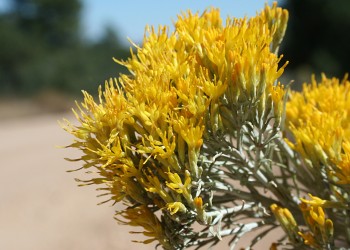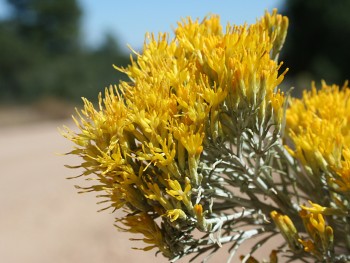Common Plants of the Gila
The Gila National Forest is a unique area of diverse native plant life. Over 1500 plant species are found here, adapted to environments from dry desert to mountains. This guide will help you learn about the plants that make the Gila special.
So Many Plants!
The Gila National Forest is a hotspot of native plant diversity, in part because of its size: 3.3 million acres. Another factor is its unique location in southwest New Mexico, where the Rocky Mountains, Sierra Madre Occidental, and Chihuahuan and Sonoran Deserts all converge and contribute some of their plants (no giant saguaros, though – those are strictly Sonoran). The Gila’s large elevational range, from 4,100 ft. to almost 11,000 ft., also contributes to its large variety of plants.
The Gila National Forest has it all. High mountaintops with towering blue spruce and Douglas fir. Vast, aromatic ponderosa pine forests. Welcoming oak-juniper-piñon pine woodlands. Streams lush with willows, cottonwoods, sycamores, and alders. Expansive lower elevation grasslands.
And that’s just for starters.
No one knows the exact number, but a reasonable estimate is that the Gila is home to about 1,500 plant species. The sheer number of plants can be daunting for beginners who want to learn to identify plants.
Common Plants of the Gila By Type
Flowers of the Gila

Grasses, Cactus & Agave of the Gila

Trees & Shrubs of the Gila

More About Plants of the Gila
Mullein Flower Closeup
(Photo Credit Courtesy of Andrew Tree)The Gila National Forest is home to hundreds of native plants, defined as those that have evolved in this area over tens of thousands of years. Unfortunately, the Gila also has non-native plants, aka invasive, noxious, or alien plants or weeds. These are plants that were introduced from another part of the world, either intentionally or accidentally. They are not subject to the natural checks and balances in their new ecosystems, where they can outcompete native plants.
In extreme cases, non-natives can displace native plants and completely take over an area. This is a problem because native plants provide food, cover, and nesting sites for many species of birds and other wildlife. Invasive plants are almost always a poor substitute for natives.
Speaking of natives, the Gila National Forest has identified 21 "Species of Conservation Concern", vulnerable plants that deserve special protection. There are also a few endemic species (plants that grow nowhere but in the Gila). How special is that?
Western Wallflower orange
(Photo Courtesy of Andrew Tree)While it’s true that botanical terms are minimized in the following webpages, some organizational terminology will help you make sense of plants. Just as people and other animals do, plants have families, too. Because plants in the same family are closely related, they share certain qualities with their cousins. Learning the characteristics of a few common plant families can make plant ID easier.
A few examples: In the bean family (Fabaceae), the flowers develop into pods that contain the seeds. Flowers in the mustard family (Brassicaceae) all have four petals in the shape of an X or cross. Plants in the mint family (Lamiaceae) have square stems, leaves that are arranged directly opposite each other on the stems, and often smell minty.
(No doubt you’ve noticed by now that plant families end in “aceae,” pronounced “ACE-ee-ee.” But in general, don’t worry about pronunciation of scientific names.)
In the arid Southwest, where water is relatively scarce, riparian areas (areas next to streams) host more and different plants than are found in the rest of the Gila’s forests. For this reason, it’s important to treat the Gila’s streams and rivers with special respect and care. Of course, every part of the forest deserves respect!
When you’re in the Gila, you might become so enchanted by a plant that you want to take it home with you. We understand. But please be aware that transplants often don’t survive. And even if you’re a transplanting pro, you’re required to have a collecting permit.
Or, consider leaving the plant in the ground and instead taking a selfie with your new plant friend.


















